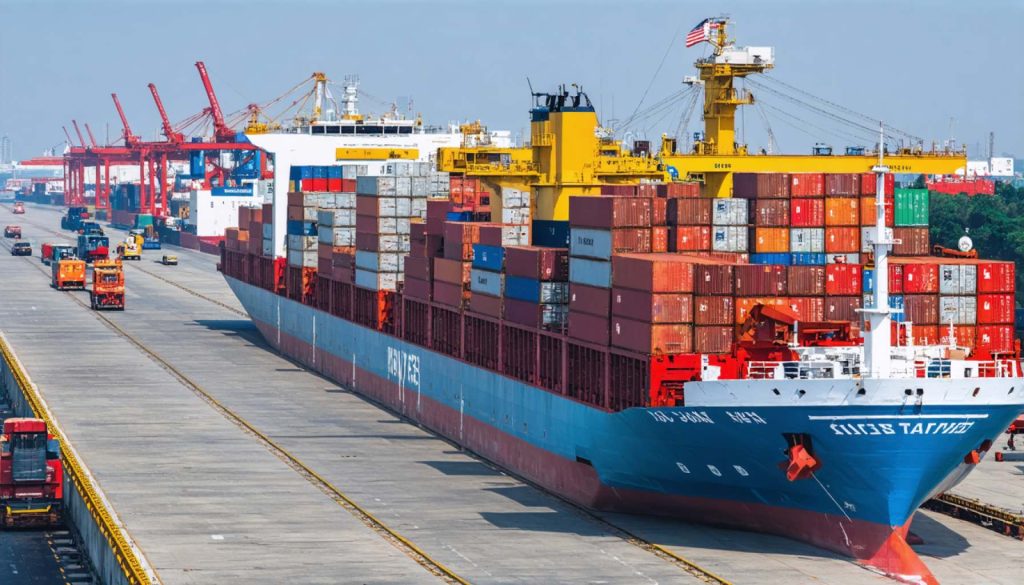
- The US has imposed new tariffs affecting major Indian export sectors such as electronics, smartphones, fisheries, gems, jewellery, auto components, and textiles.
- Indian businesses are focusing on diplomacy and adaptability, seeking government negotiations and bilateral trade agreements to mitigate tariff impacts.
- India’s shrimp sector faces a 27% tariff, while smartphone exports may benefit from relatively lower tariffs compared to China’s.
- These tariffs aim to reduce US trade deficits and boost domestic manufacturing but also enhance India’s potential as a reliable supply chain partner.
- India has secured exemptions for pharmaceuticals and petroleum exports, lessening the impact but leaving other sectors vulnerable.
- The situation highlights the need for strategic diplomacy, offering opportunities despite challenges.
The delicate dance of international trade is once again shifting, as the US unveils a series of tariffs that stand to ripple through India’s prominent export industries. The latest policy, a bold stroke under the current US administration, casts a spotlight on sectors such as electronics, smartphones, fisheries, gems, jewellery, auto components, and textiles.
With newfound urgency, Indian businesses lean heavily on the power of diplomacy and adaptability. There’s a push for robust government-to-government negotiations to bring some relief from these economic headwinds, while several industries are keenly eyeing bilateral trade agreements (BTAs) to cushion the blow.
Take, for instance, the Indian shrimp sector now burdened by a 27% tariff on frozen shrimp. The aquatic bounty of India’s seas, a product often destined for American tables, suddenly finds its pathway littered with obstacles. The strategy to counteract this involves seeking a smoother course through mutual recognition agreements that could slice through non-tariff barriers.
Meanwhile, the world of electronics and smartphones braces for its own challenges. For the tech-savvy, there’s a silver lining. Despite matching tariffs, India’s smartphone exports might still glide through smoother waters than their Chinese counterparts, which face a staggering 54% tariff. This presents a unique advantage for India, one that hinges on maintaining its competitiveness even as the stakes rise.
Interestingly, while these tariffs seek to reduce trade deficits and foster domestic manufacturing within the US, they inadvertently open doors for further collaboration. American firms are increasingly considering India as a robust supply chain partner, appreciating its reliability amid a turbulent trade landscape.
India isn’t entirely at the mercy of these new tariffs. Securing exemptions for pharmaceuticals and petroleum products, which constitute nearly 20% of its exports to the US, offers a moment of respite. Yet, the remaining 80% remains vulnerable, and negotiations continue to be pivotal.
There’s a method beneath the apparent madness of tariffs, a strategic reimagining of alliances and economies. A keen eye on evolving trade policies in the US might just reveal opportunities for strategic partnerships, particularly within sectors not traditionally linked to Indian exports.
As the world holds its breath, India stands afoot the precipice, ready to leap or fall. The message is clear: adaptability, foresight, and strategic diplomacy could transform looming challenges into gateways of opportunity.
New US Tariffs on India: Challenges, Opportunities, and Strategic Moves
The US administration’s recent imposition of tariffs on a variety of Indian export sectors, such as electronics, smartphones, fisheries, gems, jewelry, auto components, and textiles, is reshaping the landscape of international trade. To navigate these challenges, Indian businesses and policymakers are focusing on diplomacy, adaptability, and strategic negotiations.
How These Tariffs Impact India’s Key Sectors
1. Electronic and Smartphone Industry: With India’s smartphone exports facing a not-insignificant tariff, they’re still less severe compared to the 54% levied on Chinese counterparts. This situation provides a unique competitive edge for India, suggesting real potential for strengthening its position in global supply chains (source: Apple).
2. Seafood Industry: The 27% tariff on Indian frozen shrimp is a significant hurdle. This sector can explore other markets where Indian aquaculture products are in high demand, such as Europe and Southeast Asia, or improve cost-competitiveness through technological advancements in aquaculture.
3. Textiles and Apparel: To counteract the increased tariffs, textile industries could shift towards value-added products and invest in sustainable fashion, which is gaining popularity in the US market.
Strategic Adaptations and Opportunities
– Bilateral Trade Agreements (BTAs): There is a pressing need for India to negotiate BTAs that could alleviate some of these tariff pressures, providing smoother market access and fostering mutual economic growth.
– Mutual Recognition Agreements (MRAs): These could cut through non-tariff barriers, particularly important for sectors like electronics and pharmaceuticals, which see significant compliance and standard challenges.
– Domestic Policy Adjustments: By incentivizing domestic manufacturing and reducing production costs through economic reforms, India can boost its export competitiveness.
Real-World Use Cases: Leveraging India’s Advantages
– Pharmaceuticals and Petroleum: These sectors, constituting nearly 20% of India’s exports to the US, have secured tariff exemptions. By focusing on innovation and quality in pharmaceuticals, India can widen its market share in the US.
– American Investment: With tariffs affecting Chinese exports more severely, American companies are likely to look for more stable supply chain partners. This presents an opening for Indian industries to position themselves as reliable partners.
Controversies & Limitations
– Short-Term Pain for Long-Term Gain?: The immediate economic strain on affected sectors is undeniable. However, these tariffs might prompt much-needed structural changes within India’s export economy.
– Trade Deficit Concerns: While these tariffs aim to reduce the US trade deficit, they could also strain bilateral relations, possibly leading to retaliatory measures.
Insights & Predictions
– A Shift in Global Manufacturing Hubs: As companies seek to diversify away from China, India stands to benefit positionally if it can offer competitive tariffs, skilled labor, and reliable infrastructure.
– Emerging Markets: By expanding into other developing markets, Indian exporters can reduce dependency on traditional markets like the US.
Actionable Recommendations
– Strengthen Diplomatic Relations: Engage in proactive dialogues with US counterparts to seek potential exemptions and carve out favorable trade terms.
– Explore New Markets: Diversify export strategies by tapping into emerging markets and regional trade partnerships.
– Enhance Production Efficiency: Invest in technology and innovation to reduce production costs and improve product quality across affected sectors.
With these strategies, India can not only mitigate the immediate impacts of the US tariffs but also position itself for sustainable growth in a rapidly evolving global trade environment. Remember to stay informed about the evolving trade relations to make the most strategic business decisions.



